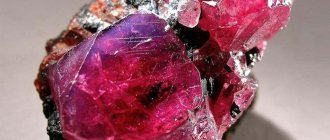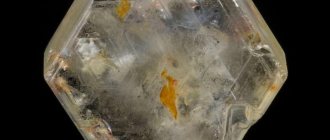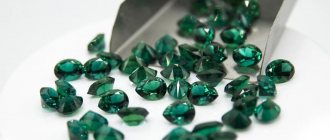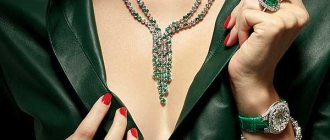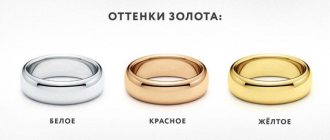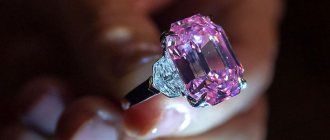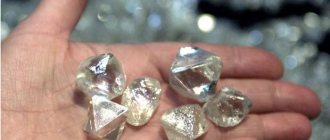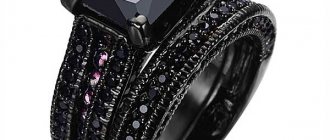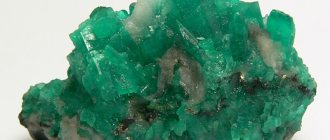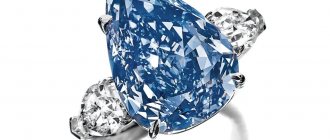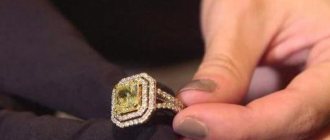A lady finds herself in a difficult situation when she finds herself in a store hoping to choose some jewelry for herself. The stones sparkle and shimmer, the price tags are confusing, the tags do not clarify anything - in general, the situation is almost hopeless. Sellers are ready, in principle, to answer any question, but what to ask is unknown. You can’t ask a nice girl: “Is that green one over there a good stone? Isn’t it a fake?”
Precious stones, transparent and hard, are rare in nature and therefore are expensive. These include diamond, natural pearl, sapphire, emerald and ruby.
However, diamond occupies a special place among them. It combines exceptional hardness, high light refraction and high gloss.
Diamond
Diamonds are made up of pure carbon atoms that exist deep underground, subjected to intense heat and pressure over billions of years.
What can it be confused with?
The greatest similarity is found in cubic zirconia (colorless zircon created by laboratory synthesis at the Physical Institute of the P.N. Lebedev Academy of Sciences). Although they are very similar in appearance, if you look closely, cubic zirconia gives less colorful highlights. Beryl, sapphire, topaz, and quartz are also passed off as diamonds.
Price
Diamonds are piece goods. A high-quality diamond weighing 1 g costs hundreds of thousands of rubles.
Tips for choosing
Let's try to understand the mineral according to the parameters indicated on the price tag.
The cost of any gemstone is made up of four factors: weight, shape, color and quality.
Weight is measured in carats (in ancient times, this word was used to describe special seeds with which the size of a pebble was compared). 1 carat is equal to 0.2 g. The price per carat increases with the weight of the diamond. A particularly sharp jump in price is observed at the 1-carat mark, when the price of identical stones weighing 0.99 carats and 1 carat differs by approximately 1.3 times, since it is believed that a “real” diamond starts at 1 carat. Depending on their weight, diamonds are divided into small (up to 0.29 carats), medium (from 0.30 to 0.99 carats) and large (more than 1 carat). If the diamond is too small, its mass is measured in “points”, which are 0.01 of the carat, that is, only 2 mg.
Form. This is the type of cut: round, oval, etc. This determines how the stone “plays” and glows. Round shape (Kr) is the most common option. Ovals and hearts are cut less frequently and are cheaper. The cut can be simplified, with 17 facets (Kr-17) (for small stones) and complex - with 57 and 58 facets (Kr-57). Another point that influences the evaluation of a stone is the quality of the cut (symmetry, polishing, etc.), evaluated by the letters “A”, “B”, “C”, “D”, where the first one denotes the highest class.
Color. Due to the peculiarities of the diamond formation process, only a few specimens are truly colorless stones. The more colorless a “white” diamond is, the higher its value. These rules do not apply to fancy colored diamonds. Such diamonds come in blue, pink, red, yellow, and green. They are very rare, and their cost is several times higher than the cost of “white” diamonds. Diamonds are classified into color groups from colorless with a gradual increase in saturation to yellow, brown, and gray shades. The number of color groups depends on the weight. Small Kr-17 diamonds are classified into 4 color groups (1 – colorless stones). Small Kr-57 diamonds are classified into 7 color groups (1 - colorless stones). Medium and large diamonds are classified into 9 main color groups (1 - colorless stones).
Purity. Diamonds are classified into clarity groups depending on the presence of internal characteristics (inclusions, cracks, surface defects, the elimination of which will lead to significant weight loss), their quantity, location and color (characteristics visible through a 10x magnifying glass are taken into account). Although these shortcomings make the product unique, their presence still makes the product cheaper. The quantity depends on the weight. Thus, small Kr-17 diamonds are classified into 6 purity groups, and small Kr-57 diamonds into 9 groups. For medium and large stones there are 12 purity groups. The relationship between color and clarity is usually expressed as a fraction, with the larger the numerator and denominator, the lower the quality of the stone. For example, a diamond with a characteristic of 3/3 is considered good, but a fraction of 9/12 indicates a very low quality of the stone.
We translate from jewelry
The “coding” of a diamond’s quality looks something like this: Kr57A-0.47-3/5. Translation from jewelry:
- Kr57A - has a round cut shape (Kr) with 57 facets (57) of very high quality (A).
- 0.47 - the second number indicates the size of the stone. Weighs 0.47 carats, that is, medium in weight.
- 3 - the penultimate number on the label indicates the degree to which the color of the stone differs from white (transparent).
- 5 - the last digit indicates the class of “purity” or quality of the stone. Our sample has few foreign inclusions.
Summary
An ideal diamond weighs from 1 carat, round grade A cut with 57 facets, colorless, pink or blue, with a color/quality ratio of 1/1 to 3/3.
Rare finds are more valuable
There is another reason why a diamond and an emerald with similar parameters differ in price in favor of the latter. Compared to diamond mines, there are far fewer mines in the world where the green mineral is being developed. Therefore, there are fewer of them on the market, which increases the selling price.
Much less often than an ordinary colorless diamond, its colored crystals grow in the depths of the earth. After cutting, they produce magnificent diamonds with rare shades - yellow, cognac, red, pink, blue. These specimens will surpass emeralds in price. After all, if millions of carats of transparent stones are mined per year, then bright, pure colored diamonds are counted in dozens.
The price range for large diamonds ranges from 25 to 85 thousand dollars. For emeralds, the initial count starts from 40 thousand and ends with the number 90. For more detailed information, see the article “How much do emeralds cost.”
Pearl
Natural pearls are formed in the body of an oyster if some foreign body, such as a grain of sand, gets there. The mollusk tries to get rid of it by secreting nacre, which envelops the alien, trying to neutralize its activity. The longer the pearl remains in the oyster's body, the thicker the layer of nacre around it will be. This creates a beautiful shiny gemstone - a pearl.
Natural pearls belong to the category of the rarest and most expensive precious stones. Pearls are not processed by jewelers - they are used in their original form.
What can be confused with
Nowadays, most pearls sold in stores are cultured specimens, grown with the help of humans (a bead is placed in an oyster, after which the pearl formation process continues in the same way as in nature). It is believed that cultured pearls have the same properties as natural pearls. The main difference between natural and cultured pearls is that cultured pearls are harvested much earlier than natural ones, and therefore the layer of nacre on them is very thin.
Price
The price of the final product will depend on the color, growing conditions (sea or river water), thickness of the pearlescent layer, surface gloss, size and shape. As the size increases, the price increases unevenly: a 9 mm pearl costs twice as much as an 8.5 mm pearl. At the same time, river pearls are traditionally valued less than sea pearls. There are no perfectly round pearls, so rounded ones are valued more than crooked ones, but non-standard specimens shaped like snails, for example, are also not cheap. Naturally colored pearls cost more than white pearls, while artificially colored pearls cost less. White and pink pearls are most valued, followed by gold (champagne) and black (Tahitian).
Color
Pale pink, silver, yellowish, light green, white, black, rose red. Sizes range from microscopic to a pigeon egg.
Tips for choosing
If you decide to purchase pearls, compare the quality of what is offered in stores. Take a closer look at the product as a whole: the shine is good, but the roundness is not important; shine and color are normal, but the surface is uneven; The shape is good, but there is no harmony among the pearls in the string.
Place the pearls on your neck or face and make sure their color matches your skin and hair color. Ask if the color is natural. Freshwater pearls are easy to distinguish from sea pearls: they are small and shaped like crooked pearl grains.
Summary
The ideal pearl is natural, marine, shiny and smooth to the touch, without potholes or depressions, round in shape, large in size, white, pink or gold in color.
Pink ones are cheaper
Rubies and emeralds of the same size and quality are valued according to the same criteria as indicated above for other precious minerals. Among the red yachts, those caught in Myanmar (formerly Burma) are valued. The special chemical composition makes Burmese crystals burn with fire.
Having such an amazing visual effect, Burmese rubies force jewelry lovers to pay tens of times more money for them than, for example, for Thai stones. In daylight, these minerals acquire a brownish tint, which causes sellers to lower the price.
Only pink rubies are cheaper than emeralds, and the blood-red stone seems to shout: “Choose me and don’t spare the money.” Which is what wealthy buyers end up doing. And those who cannot afford it choose, for example, topaz inserted into a gold frame.
Sapphire
Sapphire is known in the mineral world as corundum, whose crystal structure is composed of aluminum oxide. On the hardness scale, sapphire is the hardest gemstone after diamond.
Color
Rare stones of rich cornflower blue color are considered the most valuable. More often there are simply blue, green, yellow, white, pink and brown stones.
What can be confused with
Often the role of sapphire is painted cubic zirconia.
Tips for choosing
The origin of a sapphire greatly influences its value. The homeland of the best sapphires is Kashmir. The color of these stones is cornflower blue. In addition, Kashmir sapphires retain color under artificial light, which is rare for this crystal.
Price
Natural sapphires are very rare and expensive. The purer the blue color of natural sapphire, the higher the price. Darker or paler stones have less value. The price is also affected by the brightness and cut of the stone and the carat weight. The best quality sapphire is one whose purity is visible to the eye, and some inclusions are detectable under a magnifying glass. Sapphires weighing up to 2 carats are more common, but stones from 5 to 10 carats are also found.
However, a gemological3 certificate confirming that the mineral was mined in Kashmir does not yet guarantee its high quality. Burmese sapphires can also be of excellent quality. Sapphires from Sri Lanka are usually paler. The darkest and therefore cheapest sapphires are mined in Australia.
Summary
It is better to look for a sapphire from Kashmir, pure cornflower blue in color, with a good cut, weighing several carats, the inclusions of which should not be visible to the naked eye.
A number of precious competitors
Traditionally, the most expensive jewelry is considered to be those encrusted with diamonds. And few people doubt that this stone can outshine other minerals. But this is an indisputable fact. Sapphires and rubies are often much more expensive. The main competitor of diamond is emerald.
The acquired popularity of processed diamonds is due to the large number of deposits and the competent advertising policy of managers. However, the uniqueness of the finds, that is, the degree of rarity, plays a significant role in the assessment. The price also depends on where the crystals are mined.
Starting to compare emerald with other stones that nature produces, let’s identify minerals that can be put on par with it in terms of the beauty of their radiance:
- diamond (diamond);
- sapphire;
- ruby.
All these stones are classified as precious, but the most expensive of them is not always a diamond. Let's figure out in order which stone is the most valuable.
Emerald
Emerald is one of the most revered and expensive gemstones. The stone belongs to the beryllium genus, whose crystal structure consists of aluminum and beryllium. Unlike other green stones, it retains its color under artificial light.
Most natural emeralds have cracks and internal defects visible to the eye, and uneven coloring.
Price
The brighter the green, the higher the cost. Unlike a diamond, a beautifully colored emerald does not lose much in value if it contains inclusions. Natural emeralds of the highest quality weighing more than 2 carats are very rare and very expensive.
What can be confused with
A stone that is too pale in color may not be an emerald, but ordinary beryl or inexpensive fluorite. You can distinguish natural emeralds from synthetic ones based on the fact that most natural emeralds are imperfect, have cracks, and are opaque in places. Perfect dark green and perfectly transparent emeralds will most likely turn out to be high-quality synthetics.
Color
There are five types of emeralds: dark green, normal green, medium green, light green, light green. The most valuable are emeralds, the color of which is close to the color of dill.
Tips for choosing
It is good that the emerald passes the examination of a gemological laboratory.
When purchasing, give preference, if possible, to a larger stone; all its play is most noticeable in it.
Summary
It is most pleasant to own a stone of 1 carat or more, always with inclusions that will guarantee its authenticity. The cut should be neat, the edges without jagged edges or roughness. The color is rich green, close to the color of dill. A conclusion from a gemological laboratory would also be useful.
Rubies are record holders in price
Red yakhont or ruby is another representative of corundum, its strength is the same as that of sapphire. The indicator is 9, which is higher than the hardness of emerald. Among the shades, the richest purple color is most valued. In the absence of defects and additional impurities in the stones, the minerals are worth fabulous money.
Blood-red rubies with high transparency are even valued at 120 thousand dollars per carat. This is a premium stone. There is a known case when a buyer paid 30 million dollars for a ruby (25.5 carats). History knows no examples of such a sum being paid for an emerald of the specified weight, even the highest quality.
Large yachts are found very rarely. For them, a weight of 40 carats is considered unique.
Once upon a time, a huge ruby weighing 951 carats was mined in India. But this figure is nothing compared to emerald nuggets. After all, it happens that they weigh several tens of thousands of carats.
This uneven ratio makes the ruby more valuable.
How much is gold worth
Jewelry does not contain pure aurum, but a properly selected mixture of common and precious metals. The amount of pure gold per gram determines the value of the alloy.
Aurum without impurities is not used in the jewelry industry because of its softness; polishing on such a product is short-lived. The amount of other metals in the mass of the product determines the sample and the cost per gram. Silver, zinc, copper, palladium, and nickel are used as additives in casting. 24-karat gold without impurities has a purity of 999 and an average price per gram of 2,600 rubles. Metal of 375 standard includes silver and copper, costs about 1000 rubles.
Who should wear it
Products with green ice and an indestructible gem can be worn by all zodiac signs without exception. Precious stones will be able to give:
- Unrestrained Scorpios - a sense of tact. People will learn to build mutually beneficial relationships with both subordinates and superiors.
- Indecisive Virgos - self-confidence. They will stop paying attention to the opinions of others. And when an individual is full of positive energy, then the brain works more efficiently. Things will go uphill for those who own minerals.
- Taurus - by willpower. Self-discipline will be their watchword. Shy representatives of humanity will have the ability to refuse without remorse.
- Young Aquarius - strong memory and mental abilities. People's aspirations will become clear to them, they will be able to guess the thoughts and feelings of others and act in accordance with them.
- Sagittarius - external attractiveness.
- Pisces - the desire to work hard and move up the career ladder. People will find physical and moral strength to help colleagues, to fulfill their direct professional responsibilities, and to solve additional tasks from their superiors.
- Rakov - excellent intuition. Those born under this zodiac sign will be able to solve a complex professional or personal problem and find a way out of any life situation. They will feel which tasks are worth doing and which tasks are better to refuse.
- Aries - motivation to do useful things. Everything planned will be completed in a short time. And the desire to work will not disappear throughout the working day.
- Capricorn - the ability to accept things as they are.
- Libra - sincere joy for the achievements of others. They will be able not to envy when an acquaintance receives a promotion, or a colleague receives an increase in salary.
- Irritable Gemini - calmness. Inner harmony will become their constant companion.
- Lviv - self-esteem. People will stop humiliating themselves in front of higher officials and will engage in self-realization.
Emerald and diamond are two precious crystals, approximately the same in cost, beauty and magical abilities.
